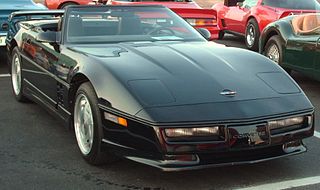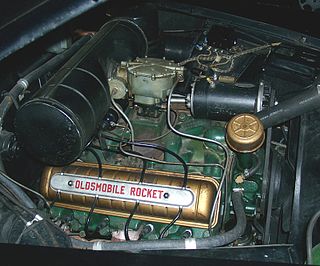
The Buick Skylark is a passenger car formerly produced by Buick. The model was made in six production runs, during 46 years, over which the car's design varied dramatically due to changing technology, tastes, and new standards implemented over the years. It was named for the species of bird called skylark.

The Northstar engine is a family of high-performance 90° V engines produced by General Motors between 1993 and 2011. Regarded as GM's most technically complex engine, the original double overhead cam, four valve per cylinder, aluminum block/aluminum head V8 design was developed by Oldsmobile R&D, but is most associated with Cadillac's Northstar series.

The Y platform, or Y body, designation has been used twice by the General Motors Corporation to describe a series of vehicles all built on the same basic body and sharing many parts and characteristics. The first was for a group of entry-level compacts including the conventional front-engine compacts built by GM divisions Buick, Oldsmobile and Pontiac from 1961 to 1963. The second, and current, incarnation is used for a high-end rear-wheel drive sports-car platform from the 1970s through the 2000s.

The Iron Duke engine is a 151 cu in (2.5 L) straight-4 piston engine built by the Pontiac Motor Division of General Motors from 1977 until 1993. Originally developed as Pontiac's new economy car engine, it was used in a wide variety of vehicles across GM's lineup in the 1980s as well as supplied to American Motors Corporation (AMC). The engine was engineered for fuel efficiency, smooth operation, and long life, not for performance. Total Duke engine production is estimated to be between 3.8 and 4.2 million units.

The Chevrolet Citation is a range of compact cars that was produced by Chevrolet from the 1980 to 1985 model years. The first front-wheel drive Chevrolet, the Citation replaced the Chevrolet Nova as the automaker downsized its compact cars. Initially slotted between the Chevrolet Monza and the Chevrolet Malibu in the Chevrolet product line, the model line was later marketed between the Chevrolet Cavalier and the Chevrolet Celebrity.

The Buick V6 is an OHV V6 engine developed by the Buick division of General Motors and first introduced in 1962. The engine was originally 198 cu in (3.2 L) and was marketed as the Fireball engine. GM continued to develop and refine the 231 cu in (3.8 L) V6, eventually and commonly referred to simply as the 3800, through numerous iterations.

The Oldsmobile V8, also referred to as the Rocket, is a series of engines that was produced by Oldsmobile from 1949 until 1990. The Rocket, along with the 1949 Cadillac V8, were the first post-war OHV crossflow cylinder head V8 engines produced by General Motors. Like all other GM divisions, Olds continued building its own V8 engine family for decades, adopting the corporate Chevrolet 350 small-block and Cadillac Northstar engine only in the 1990s. All Oldsmobile V8s were assembled at plants in Lansing, Michigan while the engine block and cylinder heads were cast at Saginaw Metal Casting Operations.

The Oldsmobile Diesel engine is a series of V6 and V8 diesel engines produced by General Motors from 1978 to 1985. Their design was based on the Olds 350 gasoline engine architecture. A 350 cu in (5.7 L) V8 was introduced in 1978, followed by a 261 cu in (4.3 L) V8 only for the 1979 model year. In 1982, a 263 cu in (4.3 L) V6 became available for both front front-wheel drive and rear-wheel drive vehicles.

The Buick V8 is a family of V8 engines produced by the Buick division of General Motors (GM) between 1953 and 1981. All were 90° water-cooled V8 OHV pushrod engines, and all were naturally aspirated except one turbocharged version of the 215.

The Pontiac Phoenix was a compact car that was sold from 1977 to 1984 by Pontiac. There were two generations of the Phoenix, both based on popular Chevrolet models, and both using the GM X platform designation. It was named for the mythological Phoenix, which would die in a self-inflicted fire and be reborn from the ashes. The Phoenix was replaced by the Grand Am in 1985.
Turbo-Hydramatic or Turbo Hydra-Matic is the registered tradename for a family of automatic transmissions developed and produced by General Motors. These transmissions mate a three-element turbine torque converter to a Simpson planetary geartrain, providing three forward speeds plus reverse.
The 4T60-E is a series of automatic transmissions from General Motors. Designed for transverse engine configurations, the series includes 4 forward gears. The 4Txx family is an evolution of the original Turbo-Hydramatic 125 transverse automatic introduced in the late 1970s and the Turbo-Hydramatic 440 transmission developed in the mid-1980s.

The General Motors H platform is an automobile platform used by subcompact cars from the 1971 to 1980 model years. The first subcompact car design developed by GM, the rear-wheel drive H platform initially underpinned the Chevrolet Vega and its Pontiac Astre counterpart. For 1975, the H platform was expanded from entry-level vehicles to sport compacts, adding the Chevrolet Monza, Buick Skyhawk, Oldsmobile Starfire, and Pontiac Sunbird.
The GM A platform was a rear wheel drive automobile platform designation used by General Motors from 1925 until 1959, and again from 1964 to 1981. In 1982, GM introduced a new front wheel drive A platform, and existing intermediate rear wheel drive products were redesignated as G-bodies.
Vehicles made by American Motors Corporation (AMC) and Jeep incorporated a variety of transmissions and transfer case systems. This article covers transmissions used in the following vehicle models and years:

The Chevrolet 90° V6 family of V6 engines began in 1978 with the Chevrolet 200 cu in (3.3 L) as the base engine for the all new 1978 Chevrolet Malibu. The original engine family was phased out in early 2014, with its final use as the 4.3 L (262 cu in) V6 engine used in Chevrolet and GMC trucks and vans. Its phaseout marks the end of an era of Chevrolet small-block engine designs dating back to the 1955 model year. A new Generation V 4.3 L (262 cu in) V6 variant entered production in late 2013, based on the LT1 small block V8 and first used in the 2014 Silverado/Sierra 1500 trucks.

The General Motors X platform is a rear-wheel drive compact car automobile platform produced from the 1962 to 1979 model years. Developed by Chevrolet, the architecture was initially unique in the U.S. to the Chevy II, first joined by the Pontiac Ventura in 1971, then a range of other GM products as its divisions expanded their compact model lines.
Saginaw Metal Casting Operations is an automobile engine foundry plant in Saginaw, Michigan. Opened under GM management in 1919, the factory produces engine blocks and cylinder heads for General Motors vehicles. The factory currently occupies 1.9 million square feet on 490 acres. Historically in September 1927 it was known as the Chevrolet Grey Iron Foundry. In the past when it was called GM-Saginaw Product Company (SPC) a cloverleaf casting symbol mark was cast onto the iron component.














